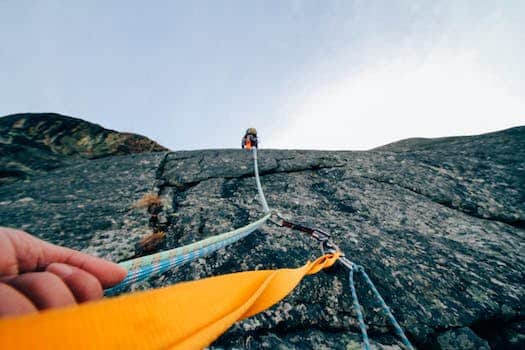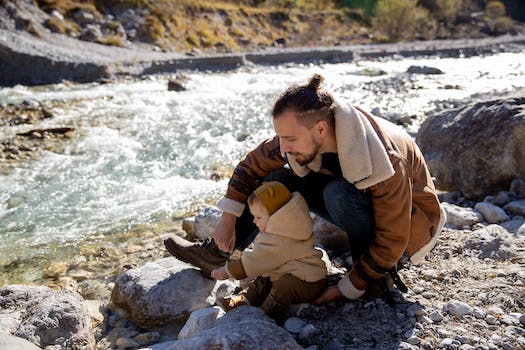Mountain climbing is an exhilarating and challenging adventure that allows you to conquer the heights and experience breathtaking views. Whether you are a novice or an experienced climber, this ultimate guide is here to provide you with all the essential information and tips you need to embark on your mountain climbing journey. From choosing the right gear and preparing physically and mentally, to understanding the techniques and safety measures involved, this comprehensive guide will equip you with the knowledge and confidence to conquer any mountain. So lace up your boots, tighten your harness, and get ready to explore the world from a whole new perspective as we dive into the ultimate guide to mountain climbing.
- 1. Introduction
- 1.1. What is mountain climbing?
- 1.2. History of mountain climbing
- 1.3. Benefits of mountain climbing
- 1.4. Popular mountain climbing destinations
- 1.5. Essential equipment for mountain climbing
- 2. Preparation and Training
- 2.1. Physical fitness and conditioning
- 2.2. Mental preparedness
- 2.3. Choosing the right mountain
- 2.4. Planning the climb
- 2.5. Acquiring necessary permits and permissions
- 3. Techniques and Safety Measures
1. Introduction
Mountain climbing is a thrilling and challenging adventure that requires strength, endurance, and determination. Whether you are a seasoned climber or a beginner looking to embark on your first climbing expedition, this ultimate guide will provide you with all the information you need to know about mountain climbing. From choosing the right gear to understanding the different types of mountains and climbing routes, this guide will help you navigate through the exciting world of mountain climbing. So, get ready to explore the mountains and push your limits as we take you on this ultimate adventure!
1.1. What is mountain climbing?
Mountain climbing is a challenging and exhilarating outdoor activity that involves ascending mountains or peaks. It is a popular sport and hobby for adventure enthusiasts who seek to conquer the heights and experience breathtaking views. Mountain climbing requires physical strength, endurance, technical skills, and mental determination. It involves navigating through rugged terrains, dealing with extreme weather conditions, and using specialized equipment such as ropes, harnesses, and crampons. The thrill of reaching the summit and the sense of accomplishment make mountain climbing an unforgettable experience. However, it is important to note that mountain climbing can be dangerous, and proper training, preparation, and knowledge of safety protocols are essential. In this ultimate guide, we will explore the various aspects of mountain climbing, including the different types of mountains, necessary equipment, essential techniques, safety measures, and tips for successful climbs.
1.2. History of mountain climbing
Mountain climbing, also known as mountaineering, is a challenging outdoor activity that involves ascending mountains. The history of mountain climbing dates back thousands of years, with evidence of early climbing activities found in various regions around the world.
The origins of mountain climbing can be traced back to ancient civilizations such as the Greeks, Romans, and Chinese. These early civilizations engaged in mountain climbing for various reasons, including religious ceremonies, exploration, and military purposes.
However, it was not until the 18th century that mountain climbing started to gain popularity as a recreational activity. The golden age of mountaineering, which took place in the 19th and early 20th centuries, saw numerous expeditions to conquer the world’s highest peaks.
One of the most significant milestones in the history of mountain climbing was the successful ascent of Mount Everest, the highest mountain in the world, by Sir Edmund Hillary and Tenzing Norgay in 1953. This achievement sparked a new era of mountaineering and inspired countless individuals to pursue their own climbing adventures.
Since then, mountain climbing has evolved into a highly organized and regulated sport, with climbers using advanced equipment, techniques, and safety measures. Today, climbers undertake expeditions to various mountain ranges across the globe, including the Himalayas, Andes, Alps, and many others.
Despite the risks and challenges involved, mountain climbing continues to attract adventurers who seek the thrill of conquering nature’s majestic peaks. It offers a unique opportunity to test physical and mental limits, experience breathtaking landscapes, and foster a deep connection with the natural world.
1.3. Benefits of mountain climbing
Mountain climbing is an exhilarating and challenging activity that offers numerous benefits for both the body and mind. Whether you are a seasoned climber or a beginner, the experience of conquering a mountain can be incredibly rewarding. In this comprehensive guide, we will explore the various benefits of mountain climbing and provide useful tips and advice to help you embark on your own mountaineering adventure.
1.4. Popular mountain climbing destinations
Mountain climbing is a thrilling and adventurous activity that attracts outdoor enthusiasts from all around the world. Whether you are an experienced climber or a novice looking to embark on your first climbing expedition, there are numerous popular destinations that offer magnificent peaks and breathtaking views. In this guide, we will explore some of the most renowned mountain climbing destinations that should be on every climber’s bucket list. From the towering peaks of the Himalayas to the rugged terrain of the Andes, these destinations provide a variety of challenges and rewards for climbers of all skill levels.
1.5. Essential equipment for mountain climbing
Mountain climbing is an exhilarating and challenging activity that requires the right equipment to ensure safety and success. Whether you are a beginner or an experienced climber, having the essential gear is crucial for your adventure. In this section, we will discuss the must-have equipment for mountain climbing, which includes the following items:
2. Preparation and Training
Before embarking on a mountain climbing expedition, proper preparation and training are essential. It is important to understand that climbing mountains can be physically and mentally demanding, and being well-prepared can make all the difference in ensuring a safe and successful climb.
One of the first steps in preparing for mountain climbing is to assess your current fitness level. Climbing mountains requires a certain level of physical strength and endurance, so it is recommended to engage in regular cardiovascular exercises, strength training, and flexibility exercises to improve your overall fitness.
Additionally, it is crucial to acquire the necessary climbing skills and knowledge. This can be done by attending mountaineering courses offered by experienced climbers or joining a local climbing club. Learning about different climbing techniques, safety procedures, and equipment usage is vital to ensure your safety during the climb.
Furthermore, familiarize yourself with the specific mountain you plan to climb. Research its altitude, weather conditions, terrain, and any potential risks or challenges that may arise. This will help you determine the appropriate gear and equipment needed for the climb.
Lastly, it is highly recommended to go on practice climbs or hikes to simulate the conditions you will face during the actual mountain climb. This will allow you to test your physical fitness, practice your climbing techniques, and become familiar with using your gear. It is also a great opportunity to build your stamina and gain confidence in your abilities.
In conclusion, proper preparation and training are crucial components of mountain climbing. By assessing your fitness level, acquiring necessary skills and knowledge, researching the mountain, and engaging in practice climbs, you can ensure a safe and successful mountain climbing experience.
2.1. Physical fitness and conditioning
Physical fitness and conditioning is crucial for a successful mountain climbing expedition. It is important to prepare both mentally and physically before embarking on such a challenging adventure. This section will focus on the necessary steps for proper preparation and training.
First and foremost, it is essential to consult with a healthcare professional or a certified trainer before beginning any physical fitness regimen. They can assess your current fitness level and provide guidance on how to proceed.
A well-rounded training program for mountain climbing should include a combination of cardiovascular exercises, strength training, flexibility exercises, and endurance training. Cardiovascular exercises such as running, cycling, or swimming help improve your stamina and lung capacity, which are vital for climbing at high altitudes.
Strength training exercises like weightlifting or bodyweight exercises target the muscles needed for climbing, such as the legs, core, and upper body. Building strength in these areas will enhance your ability to carry heavy backpacks, navigate difficult terrains, and perform challenging climbing maneuvers.
Flexibility exercises, such as yoga or stretching routines, are essential for maintaining joint mobility and preventing injuries. Mountain climbing requires a wide range of motion, so it is crucial to keep your muscles and joints flexible.
Endurance training is another key aspect of preparation. This involves gradually increasing the duration and intensity of your workouts to build up your endurance levels. It is important to simulate climbing conditions as much as possible, such as hiking on steep inclines or using a stair climber.
In addition to physical training, mental preparation is equally important. Mountain climbing can be mentally demanding, requiring focus, concentration, and the ability to overcome challenges. Techniques such as meditation, visualization, and positive affirmations can help train your mind to stay calm and focused during difficult situations.
Overall, physical fitness and conditioning are essential for mountain climbing. By following a well-rounded training program and preparing both physically and mentally, you can increase your chances of a successful and enjoyable climbing experience.
2.2. Mental preparedness
Mental preparedness is an essential aspect of mountain climbing. The physical challenges of climbing are only part of the equation; a strong and focused mind is equally important. Before embarking on any mountaineering expedition, it is crucial to develop mental resilience and preparedness.
One key aspect of mental preparedness is understanding the risks and uncertainties associated with mountain climbing. Climbers must be aware that they will face unpredictable weather conditions, difficult terrains, and potential dangers. This knowledge helps climbers to mentally prepare themselves for any unexpected situations that may arise during their climb.
Another crucial aspect of mental preparedness is setting realistic goals and managing expectations. Mountain climbing requires immense physical and mental stamina, and it is important to set achievable goals that match one’s fitness level and experience. This helps prevent frustration and disappointment, leading to a more positive and focused mindset throughout the climb.
Additionally, mental preparedness involves practicing mental visualization and positive self-talk. Visualizing successful climbs and envisioning oneself overcoming challenges can boost confidence and motivation. Positive self-talk helps to maintain a positive mindset and overcome self-doubt during difficult moments.
Lastly, building mental resilience through regular training and conditioning is essential. Engaging in activities such as meditation, mindfulness exercises, and mental strength training can help climbers develop the mental fortitude required to overcome obstacles and push through tough situations.
In conclusion, mental preparedness is a critical component of mountain climbing. By understanding the risks, setting realistic goals, practicing mental visualization, and building mental resilience, climbers can enhance their overall performance and increase their chances of a successful and fulfilling climb.
2.3. Choosing the right mountain
Choosing the right mountain for section with title Preparation and Training
2.4. Planning the climb
Before embarking on any mountain climbing expedition, proper planning is essential. This involves careful consideration of various factors such as the difficulty level of the climb, the weather conditions, and the necessary equipment. Here are some key steps to take when planning your climb:
1. Research the mountain: Start by gathering information about the mountain you intend to climb. Learn about its terrain, altitude, and any potential risks or challenges you may encounter.
2. Set clear goals: Determine what you aim to achieve from the climb. Whether it is reaching the summit or exploring a specific route, having clear goals will help you stay motivated throughout the process.
3. Create a detailed itinerary: Plan your climb day by day, considering factors like rest days, acclimatization periods, and possible emergency scenarios. A well-thought-out itinerary will help you stay organized and ensure a smoother journey.
4. Arrange necessary permits: Many mountains require climbers to obtain permits before attempting the climb. Research the permit requirements and make the necessary arrangements well in advance.
5. Assess your fitness level: Mountain climbing is physically demanding. Evaluate your fitness level honestly and consider training if necessary. Engaging in cardiovascular exercises, strength training, and hiking can help improve your stamina and endurance.
6. Gather the right gear: Invest in high-quality mountaineering gear that is suitable for the specific conditions you will encounter. This includes clothing, footwear, backpacks, ropes, harnesses, and other safety equipment.
7. Practice proper nutrition and hydration: Maintaining a healthy diet and staying hydrated are crucial for optimum performance during the climb. Consult a nutritionist if needed and ensure you have a sufficient supply of water and food for the duration of the expedition.
8. Join a climbing course or hire a guide: If you are a beginner or lack experience, it is recommended to join a climbing course or hire an experienced guide. They can provide valuable instruction, enhance your skills, and ensure your safety.
By thoroughly preparing and training for your mountain climbing adventure, you can increase your chances of a successful and enjoyable experience.
2.5. Acquiring necessary permits and permissions
Before embarking on a mountain climbing expedition, it is absolutely crucial to acquire the necessary permits and permissions. This ensures that you are legally allowed to climb the mountain and helps in maintaining the safety and preservation of the environment. Here are some important steps to follow when acquiring permits and permissions for mountain climbing:
1. Research the mountain: Start by researching the specific mountain you plan to climb. Different mountains may have different regulations and permit requirements. Understand the rules and regulations set by the local authorities and landowners.
2. Identify the permit authorities: Find out who the permit authorities are for the mountain you intend to climb. It could be a national park, a government agency, or a private landowner. Contact them to gather information about the permit application process.
3. Determine the permit requirements: Each permit authority will have its own set of requirements. These may include submitting an application form, providing medical certificates, proof of climbing experience, and paying the necessary fees. Make sure you understand all the requirements before proceeding.
4. Submit the permit application: Once you have gathered all the necessary documents, submit your permit application well in advance. Some mountains have limited permits, so it’s important to apply early to secure your spot.
5. Attend any required training: In some cases, the permit authorities may require climbers to undergo specific training or orientation programs. These programs are designed to ensure climbers are adequately prepared for the challenges they may face on the mountain. Attend any required training sessions to enhance your skills and knowledge.
6. Follow safety guidelines: Along with acquiring permits, it is crucial to adhere to safety guidelines and regulations set by the permit authorities. These guidelines may include carrying necessary equipment, climbing in designated areas, and respecting the environment.
By following these steps and acquiring the necessary permits and permissions, you can ensure a safe and responsible mountain climbing experience.
3. Techniques and Safety Measures
Mountain climbing is an exhilarating adventure that requires careful planning and preparation. Whether you are a beginner or an experienced climber, it is essential to follow certain techniques and safety measures to ensure a successful and safe climb.
One of the most important techniques in mountain climbing is proper gear selection. It is crucial to have the right equipment, including helmets, harnesses, ropes, carabiners, and climbing shoes. These items not only provide protection but also enhance your performance and comfort during the climb.
Another technique is to master the art of rope management. Knowing how to tie knots, belay, and rappel are essential skills for any climber. Understanding the different rope systems and practicing these techniques regularly can greatly improve your climbing efficiency and safety.
Safety measures play a significant role in mountain climbing. It is crucial to assess the weather conditions before starting your climb. Unfavorable weather, such as storms or strong winds, can make climbing dangerous and should be avoided. Additionally, it is important to be aware of the terrain and potential hazards, such as loose rocks or crevasses.
Proper communication is another safety measure that should not be overlooked. Climbing with a partner or a team allows for better coordination, sharing of responsibilities, and support in case of emergencies. Establishing clear communication signals and having a plan in place for emergencies can save lives.
Lastly, physical fitness and training are vital for mountain climbing. Regular exercise, including cardiovascular workouts, strength training, and flexibility exercises, can improve your endurance, strength, and agility. It is also important to acclimatize to high altitudes gradually to prevent altitude sickness.
By following these techniques and safety measures, you can enjoy the thrill of mountain climbing while minimizing risks and ensuring a successful ascent.
3.1. Basic climbing techniques
Mountain climbing requires a combination of physical strength, technical skills, and a good understanding of safety measures. In this section, we will discuss some basic climbing techniques for beginners to help them get started on their mountain climbing adventure.
1. Footwork: Proper footwork is essential for maintaining balance and stability while climbing. It is important to place your feet carefully and use the edges of your shoes to gain traction on the rock or ice.
2. Handholds: Finding and using the right handholds is crucial for climbing. Look for secure grips such as cracks, pockets, or ledges to support your weight. Use your fingers and palms to grip the rock or ice firmly.
3. Body Positioning: Maintaining the correct body position is key to efficient climbing. Keep your center of gravity close to the wall by leaning in and using your legs to push yourself up. Avoid overreaching or relying too much on your arms.
4. Belaying: Belaying is a safety technique used to protect climbers in case of a fall. It involves using a rope system to create friction and control the climber’s movements. Learn proper belaying techniques and always have a trusted partner who knows how to belay.
5. Communication: Clear communication is essential between climbers. Use simple hand signals or verbal cues to indicate your intentions or warn others about potential hazards. Practice good communication skills to ensure a safe and coordinated climb.
Remember, these are just some basic climbing techniques to get you started. It is essential to undergo proper training, gain experience, and always prioritize safety when embarking on a mountain climbing journey.
3.2. Understanding different types of terrain
Understanding different types of terrain is essential for mountain climbers. The terrain can greatly affect the techniques and safety measures required during a climb. Mountains can have various types of terrain, each presenting its own challenges and risks.
One common type of terrain found in mountains is rocky terrain. This type of terrain is characterized by the presence of large rocks and boulders, making it difficult to find stable footing. Climbers need to carefully navigate through this terrain, using proper foot placement and balance to avoid injuries.
Another type of terrain is icy or snowy terrain. This is often found at higher altitudes or during winter climbs. Climbers need to be equipped with specialized gear, such as crampons and ice axes, to safely navigate through icy or snowy surfaces. They must also be skilled in techniques like kicking steps and using ice screws to secure their ascent.
Steep and exposed terrain is another challenge faced by mountain climbers. It involves climbing on slopes with significant inclines and limited footing. Climbers must be experienced in using ropes, harnesses, and other protective equipment to ensure their safety. They need to be able to make precise movements and maintain balance while ascending or descending such terrain.
Lastly, mountain climbers may encounter loose or unstable terrain. This includes loose rocks, scree, or unstable slopes. It is important for climbers to be cautious and avoid placing excessive weight on unstable surfaces. They should test their footing before putting full weight on it and take necessary precautions to prevent rockfall or avalanches.
Understanding and adapting to different types of terrain is crucial for a successful and safe mountain climbing experience. It requires a combination of physical skills, technical knowledge, and proper equipment. By being well-prepared and knowledgeable about the specific terrain they will encounter, climbers can minimize risks and enjoy their adventure to the fullest.
3.4. Using safety equipment
When it comes to mountain climbing, safety should always be the top priority. One of the most crucial aspects of ensuring safety is to use the appropriate safety equipment. Whether you are a beginner or an experienced climber, having the right gear can make a significant difference in preventing accidents and minimizing risks.
The first and foremost piece of safety equipment you should have is a sturdy and well-fitted helmet. A helmet protects your head from potential falling rocks, ice, or debris. It is essential to choose a helmet that meets safety standards and fits comfortably.
Another crucial safety gear is a harness. A harness is used to secure yourself to the rope and anchor points. It is important to learn the proper way to wear and adjust a harness to ensure maximum safety while climbing. Always check the harness for any signs of wear and tear before each climb.
Climbing ropes are also vital safety equipment. They provide the lifeline between you and the anchor points. It is crucial to use dynamic ropes specifically designed for climbing, as they can absorb the force of a fall and reduce the impact on your body. Regular inspection and proper care of climbing ropes are essential to maintain their integrity.
In addition to ropes, carabiners are essential tools for climbers. These metal clips are used to attach ropes to anchors and various pieces of equipment. It is crucial to use locking carabiners to prevent accidental opening. Regularly inspect carabiners for any signs of damage or wear.
Climbing shoes are another important piece of equipment that provide grip and support on different terrains. They should fit snugly and offer good traction to ensure stability and prevent accidents. Invest in high-quality climbing shoes that are suitable for the type of climbing you plan to do.
Lastly, having a headlamp or flashlight is essential, especially for climbing in low-light conditions or during overnight trips. It helps you navigate and see the terrain clearly, reducing the risk of tripping or getting lost.
Remember, using safety equipment alone is not enough. It is equally important to learn and practice proper climbing techniques, understand the risks involved, and be prepared for unforeseen circumstances. Always prioritize safety and never compromise on using the necessary safety gear while enjoying the adventure of mountain climbing.
3.5. First aid and emergency protocols
When it comes to mountain climbing, being prepared for emergencies is crucial. Having knowledge of first aid and understanding the necessary emergency protocols can potentially save lives. In this section, we will discuss some essential techniques and safety measures that every mountain climber should be aware of.
First Aid:
1. Assess the situation: Before providing any first aid, it is important to assess the situation and ensure your safety as well as the safety of others involved.
2. Stop bleeding: In case of bleeding, apply direct pressure to the wound using a clean cloth or bandage. Elevate the injured body part if possible.
3. Treat fractures: If someone sustains a fracture, immobilize the injured area by using splints or any available materials to prevent further damage.
4. Provide CPR: Learn and practice cardiopulmonary resuscitation (CPR) techniques, as it may be necessary in case of cardiac arrest or respiratory distress.
Emergency Protocols:
1. Communication: Establish a reliable means of communication with your climbing group and make sure everyone knows how to use it effectively.
2. Emergency signals: Familiarize yourself with common emergency signals such as whistle blasts, hand signals, or flashlight codes. This can help you communicate distress or call for assistance.
3. Evacuation plan: Plan and discuss evacuation routes and procedures with your climbing group before starting the ascent. Identify safe areas or spots where you can take shelter in case of severe weather conditions or other emergencies.
4. Carry essential supplies: Always carry a well-equipped first aid kit, emergency blanket, extra food, water, and any other necessary equipment for emergencies.
Remember, prevention is the best approach. It is important to be cautious, well-prepared, and follow safety guidelines while mountain climbing. However, in case of an emergency, having the knowledge and skills to provide first aid and adhere to emergency protocols can make a significant difference.
Conclusion
In conclusion, mountain climbing is an exhilarating and challenging adventure that requires careful planning, physical fitness, and a strong determination to reach the summit. With the right gear, proper training, and respect for the mountains, climbers can enjoy the breathtaking views and the sense of accomplishment that comes with conquering these majestic peaks. So, if you’re up for the challenge, embrace the ultimate adventure of mountain climbing and experience the thrill of reaching new heights.





